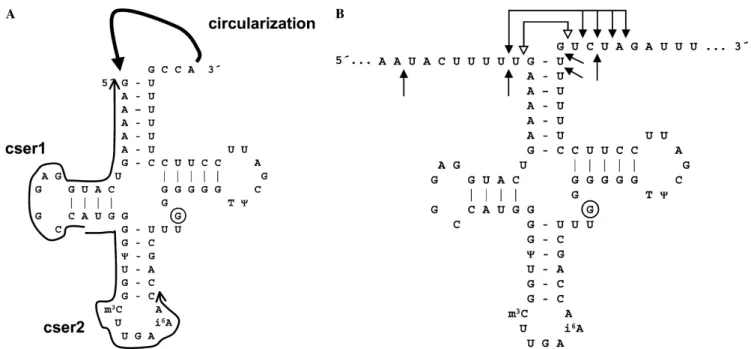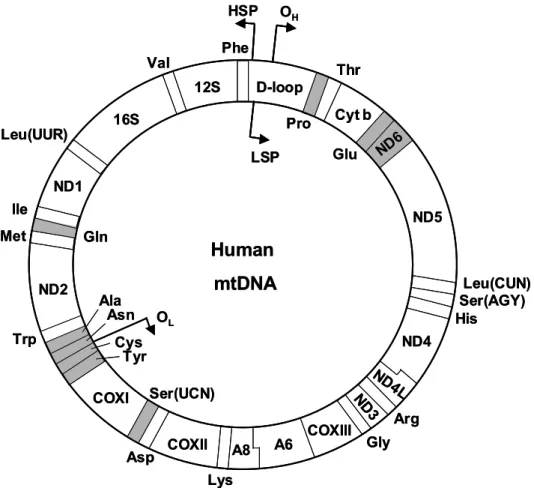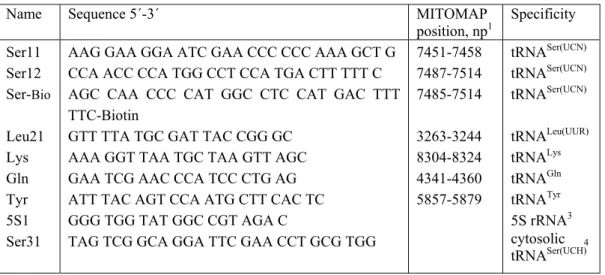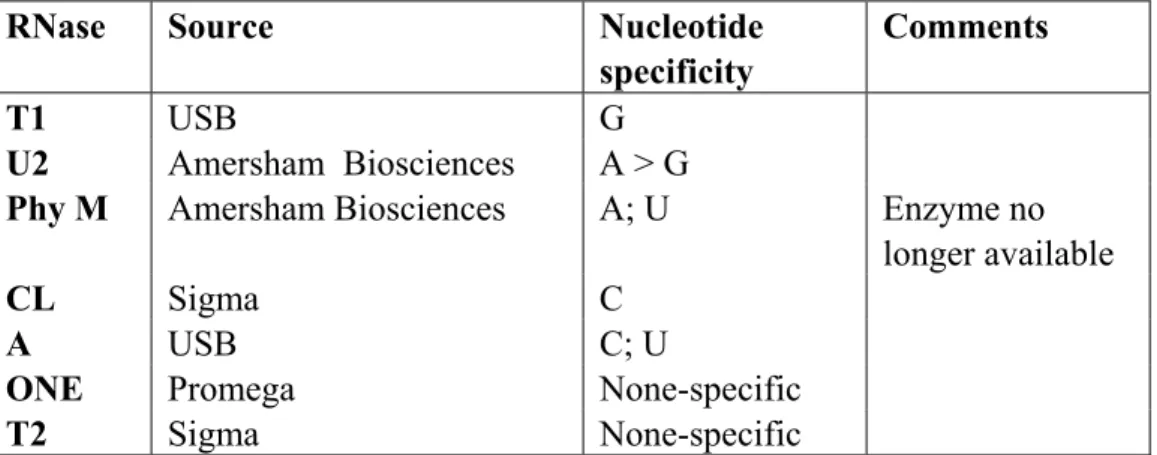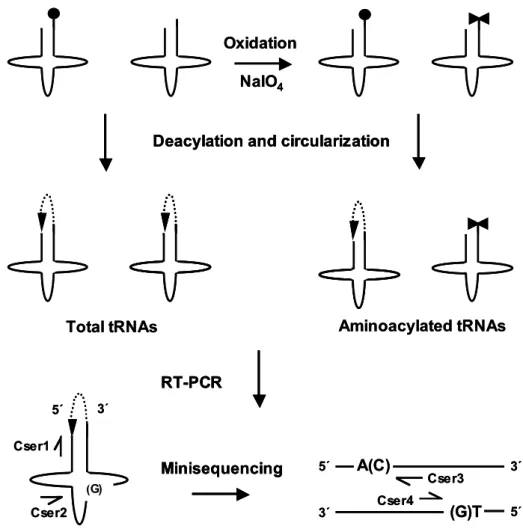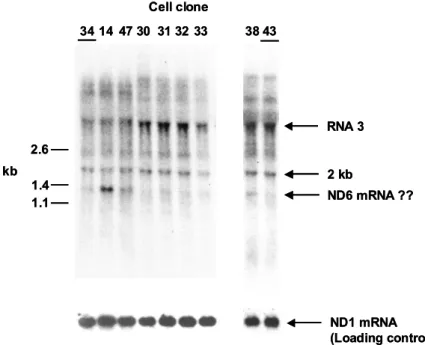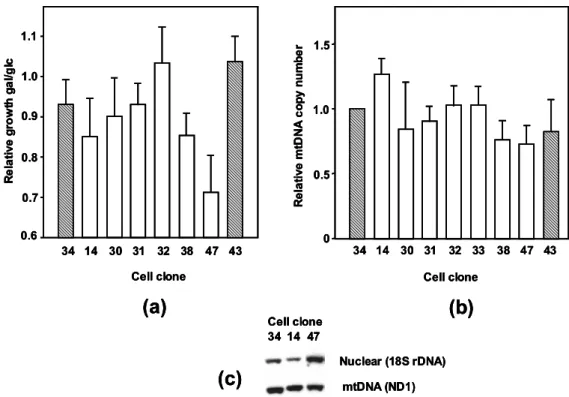The aim of my study was to characterize the molecular phenotype and the molecular mechanism of the 7472insC mutation. The functional level of the mutant tRNA was even lower, due to a 25% decrease in the extent of its aminoacylation in vivo.
INTRODUCTION
REVIEW OF LITERATURE
The mitochondrion
- Organization and function
- The respiratory chain
- The human mitochondrial genome
- Mitochondrial transcription, RNA processing and translation
The dimerization is suggested to be involved in controlling the morphology of mitochondrial cristae (Paumard et al, 2002). According to the traditional strand displacement model (Clayton, 1982), replication starts from the H strand and proceeds approximately two-thirds of the mtDNA length when the L strand begins synthesis in the opposite direction.
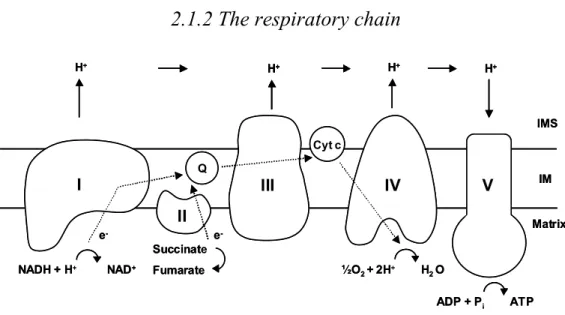
Transfer RNAs
- tRNA structure and function
- Biogenesis of eukaryotic and prokaryotic tRNAs
- The ribosome cycle
- Structural features
- tRNA Ser(UCN)
- Mitochondrial seryl-tRNA synthetase (mt SerRS)
- Aminoacylation
- Mitochondrial tRNA processing enzymes
- Mitochondrial tRNA modification enzymes
The identity elements for human mitochondrial LeuRS are located in the acceptor stem, anticodon stem and D-loop of tRNALeu (HOUR), representing a novel pattern of tRNA recognition in which the discriminator base is the only conserved element for leucylation in other systems (Sohm et al., 2004). The unique feature of the second leucine isoacceptor in human mitochondria, tRNALeu(CUN), is its flexibility due to a low number of GC pairs in the T-stem, which allows for a slip of 1 nt (Hao et al, 2005).
Mitochondrial disorders
- Overview
- Deafness-associated mutations
- Molecular effects of tRNA mutations
The unique suppression of the A3243G mutation by the G12300A mutation in the tRNALeu(CUN) anticodon (El Meziane et al, 1998b) can be explained by a partial modification of the wobble base of the suppressor tRNA, which allows it to read the UUG codon in addition to the UUA codon (Kirino et al, 2006). . Reduced levels of charged tRNALeu (UUR) with the A3243G mutation were detected in cybrid cell lines (El Meziane et al, 1998a; Chomyn et al, 2000) as well as in muscle biopsies from patients (Börner et al, 2000).
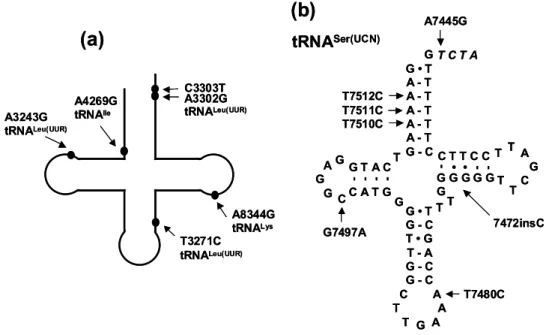
Polyadenylation of stable classes of RNA
- Functions of polyadenylation
- Polyadenylation and degradation enzymes
- tRNA polyadenylation
Significant shortening of the poly(A) tails of some mitochondrial mRNAs in the absence of PAP (Tomecki et al, 2004; .. Slomovic et al, 2005) suggests that they are synthesized by PAP. Polyadenylation is suggested to be a major component in the editing of overlapping tRNAs in metazoan mitochondria, which allows the restoration of the discriminating base by a subsequent cleavage of the poly(A) tail followed by the addition of CCA (Yokobori and Pääbo, 1997) .
AIMS OF THE STUDY
MATERIALS AND METHODS
- Mammalian cells and cell culture
- Cell lines and culture media
- Growth assays
- Transfection and cloning
- Bacterial cell culture
- Miscellaneous RNA and DNA manipulations
- Oligonucleotides
- RNA extraction and analysis by Northern hybridization
- DNA extraction and analysis by Southern hybridization
- PCR and RT-PCR
- Molecular cloning
- DNA sequencing
- tRNA structural and functional analysis
- tRNA sequencing and structural probing
- Aminoacylation assay (oxidation-circularization)
- tRNA half-life and synthesis measurements
- tRNA processing
- In vivo processing analysis
- Pre-tRNA constructs
- In vitro processing analysis
- Analysis of mitochondrial proteins
- SDS-PAGE
- Western blotting
Samples of bacterial culture were lysed on nylon membrane as described by Sambrook et al (1989) and hybridized with a 32 P-labelled oligonucleotide (see section 4.3.2). PCR probes for ND1 and 18S rDNA were prepared as described in (I) and randomly labeled as described above. Structural probing was performed under non-denaturing conditions at 37 °C on tRNA refolded in renaturation buffer (150 mM NaCl, 10 mM MgCl 2 , 20 mM Tris-HCl pH 7.5) as described in (II).
RNA was ethanol precipitated twice from a volume of 400 µl in the presence of 20 µg/ml glycogen and deacylated as described above. Constructs with or without the 7472insC mutation were prepared as described in (III). a) Constructs with a 71 bp 5'-leader sequence preceded by an EcoRI site and with a mature 3' end were generated by PCR amplification of an mtDNA fragment containing tRNASer(UCN) with primers SP6L1 to insert the promoter sequence SP6 and SerCCA1 to introduce the 3′-terminal CCA sequence. The constructs were reamplified with primers SP6S1 and SerCCA1 using Pfu DNA polymerase (Promega) to create open ends, cloned and verified by sequencing. b) 3' trailer constructs were prepared by amplifying constructs (a) with primers SP6S1 and Trail31 to insert a 25 bp trailer sequence.
The reaction products were extracted with phenol and purified by gel electrophoresis as described in (III). d) Constructs with mature 5'-ends were prepared by L.L.
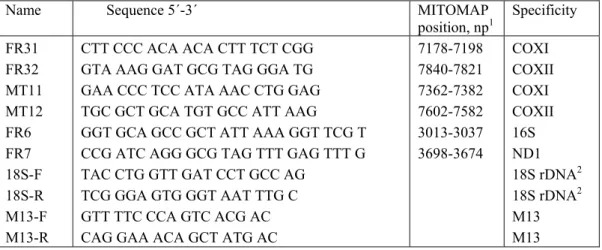
RESULTS
- Molecular and biochemical phenotype of the 7472insC mutation in
- Steady-state levels of tRNA Ser(UCN)
- Growth on galactose medium
- mtDNA copy number
- Mitochondrial protein synthesis
- The 7472insCC mutation
- Effect of the 7472insC mutation on structure and function of
- Effect on tRNA base modifications and secondary/tertiary
- Effect on tRNA aminoacylation
- Effect on tRNA turnover
- Effect of EF-Tu overexpression
- Effect of the 7472insC mutation on the synthesis of tRNA Ser(UCN)
- Total rate of tRNA synthesis (II)
- Processing of tRNA Ser(UCN) in vivo
- Interference of 3´-misprocessing with 5´-processing
- Polyadenylation of human mitochondrial tRNAs (unpublished results)
- Effect of high doses of EtBr on human mitochondrial tRNAs
- Turnover of polyadenylated tRNAs
- Studies on the mechanism of tRNA polyadenylation
The main molecular phenotype of the 7472insC and A7445G mutations is therefore a significant decrease in steady-state tRNASer (UCN) levels, which is reflected in a similar clinical phenotype. As a next step in my study, I therefore analyzed the structure of tRNAs in 7472insC mutant and wild-type cybrid cells. During EtBr treatment, the relative extent of aminoacylation of the mutated tRNA decreased slightly (Figure 5.7b).
In the next series of studies, I analyzed the molecular effects of the mutation on RNA processing in vivo and in vitro. Products of newly synthesized tRNASer(UCN) (unpublished results) During tRNA synthesis studies, a slower migrating band of tRNASer(UCN) was observed in both wild-type and mutant RNA fractions (Figure 5.10). The efficiency of 3'-processing of the mutant substrate was dependent on the presence of the 5'-leader.
Wild-type and 7472 inC mutant substrates uniformly labeled with an 83 nt 5'-leader and mature 3'-end, including CCA, 5'-processed to completion with (+) or without (- ) excess of HeLa cells RNase P. c) same substrates as in (b), wild-type mutant (w) and 7472 inC mutant (m), 5´-processed using increasing amounts (arbitrary units) of RNase P. d) Relative efficiency of the same substrates as in (b, c ) using increasing amounts of RNase P.
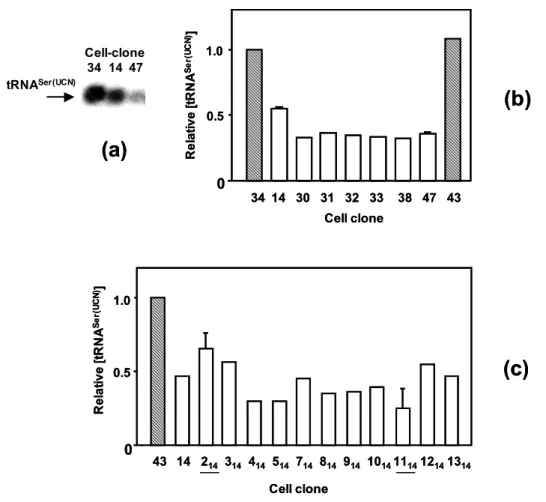
DISCUSSION
Molecular phenotype of the 7472insC mutation (I)
- Tissue specificity
- Modifying factors
- Cybrid model
- Origin of the 7472insC mutation
Mutations G7497A (Möllers et al, 2005) and, in my study, the 7472insC mutation, steady-state levels of the mutant tRNA have been demonstrated to be decreased. Surprisingly, despite extremely low steady-state levels of tRNASer (UCN) with the T7512C and G7497A mutations, the decrease in protein synthesis was comparable to that in the case of the A7445G mutation (Möllers et al, 2005; Guan et al, 1998). . A threshold of ~40% of the usual level of tRNASer (UCN) has been proposed to be required for a normal rate of translation (Guan et al, 1998).
Three of the nuclear COX subunits (VIa, VIIa and VIII) are represented in muscle-specific (H) and non-muscle-specific (L) isoforms (Grossman and Lomax, 1997). The nuclear background of the recipient cybrid cell line may contribute to the variability in the molecular phenotype as well. The suppressive effect of the G12300A mutation in tRNALeu(CUN) was also dependent on the nuclear background (Lehtinen, 2001).
The origin of the 7472insC mutation was found to be independent in six families from Western Europe (Hutchin et al, 2001).
Effects of the 7472insC mutation on molecular function of RNA Ser(UCN)
- Effect on tRNA structure
- Effect on tRNA aminoacylation
- Effect of EF-Tu overexpression
Second, even if no change was observed in the primary sequence of the tRNA, the mutation may still affect the efficiency of base modifications (see also the next chapter). However, these results provide no evidence for interference of the 7472insC mutation with the m1A58 modification. The 7472insC mutation produced a 25% relative decrease in aminoacylation that may be quite important in combination with the low steady-state levels of mutant tRNASer(UCN).
Although the preference of human SerRS may be different, in the case of tRNASer(UCN) the nature of the discriminator appears to correlate with the occurrence of the m1A58 modification, which is normally present in cattle (Yokogawa et al, 1991) but not the human tRNA (see previous section). The occurrence of this modification at a low frequency in human tRNASer (UCN) may be involved in regulation of the balance of aminoacylation. As it is one of the most abundant tRNAs in human mitochondria (King and Attardi, 1993), it can be speculated that ternary complex formation may balance the amount of tRNAs active in translation that would otherwise be present in excess, given a limited concentration of EF-Tu (Cai et al, 2000).
Since the amount of aaRSs could also be limiting, aminoacylation may be one of the stabilizing factors involved in the adjustment of tRNA steady-state levels (King and Attardi, 1993).
Molecular effects of the 7472insC mutation on tRNA biogenesis
- Interference with RNA processing
- Processing pathway of tRNA Ser(UCN)
- Interference with other maturation steps
Applying this knowledge to tRNA point mutations, any changes in the kinetics of the 'right'. In my analysis, the efficiency of 3' processing of the mutated substrate in vitro was highly dependent on the order of processing, implying that the effect of the mutation in vivo should depend on the processing route. Such a priority could be enforced by the structure of the substrate, where tRNase Z is inhibited by long 5' extensions (Nashimoto 1999; de la Sierra-Gallay et al, 2005).
A different sequence of processing in muscle and fibroblasts was observed in the case of the A3302G mutation, which results in a tissue-specific accumulation of RNA intermediates (Bindoff et al, 1993). The reduced efficiency of RNA processing may be the most important but not the only mechanism leading to the low steady state levels of the 7472insC mutant tRNASer(UCN). The transition between the L and λ forms may be a rate-limiting step of the modification reaction (Ishitani et al, 2003).
Thus, the efficiency of the reaction is likely to depend on the global conformational flexibility of the tRNA.
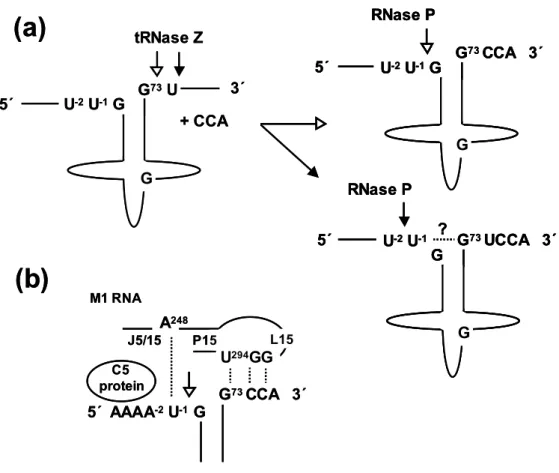
Polyadenylation of human mitochondrial tRNAs
- The tRNA polyadenylation phenomenon
- tRNA polyadenylation and turnover enzymes
- Towards the mechanism of tRNA polyadenylation
Interestingly, the length of the poly (A) tails of the most stable products was different for individual tRNAs. Optimal tail length may be required to interact with any such factor. Persistent mtDNA could therefore act as a template for transcription after drug removal.
Polyadenylation of tRNA substrate by bacterial PAP I in vitro was found to be biphasic, with a low rate of addition of the first few A residues (Feng and Cohen, 2000). Thus, the main molecular effect of the 7472insC mutation is a dramatic decrease in steady-state levels of tRNASer (UCN). While the effects of the 7472insC mutation on tRNA structure and function appeared to be minimal, a 25% defect in aminoacylation could be quite significant when combined with the low steady-state levels of the mutant tRNASer(UCN).
In addition, a threshold for expression of the effects of the mutation might depend on tissue-specific factors plus genetic and environmental factors.
CONCLUSIONS AND PERSPECTIVES
The proposed mechanism could provide some explanations for the tissue-specific effects of the mutation. My work aimed to characterize a detailed mechanism of the 7472insC mutation in a cybrid cell model. Comparative analysis of the pathogenic mechanisms associated with the G8363A and A8296G mutations in the mitochondrial tRNALys gene.
King MP and Attardi G (1993): Posttranscriptional regulation of steady-state levels of mitochondrial tRNAs in HeLa cells. Mitochondria-specific RNA-modifying enzymes responsible for swing base biosynthesis in mitochondrial tRNAs. Misprocessing at the 30 end further impaired the efficiency and accuracy of processing the 50 mutant substrate.
The A7445G mutation, which maps one nucleotide after the 30 end of tRNA [2,3], is associated with sensorineural deafness and palmoplantar keratoderma syndrome [11]. The severity of the 7472insC processing defect depends on the processing pathway used in vivo. Jacobs, Molecular phenotype of the mitochondrial deafness-associated np7472 mutation in osteosarcoma cell cybrids, Hum.
